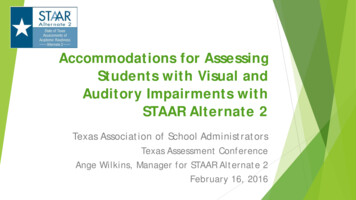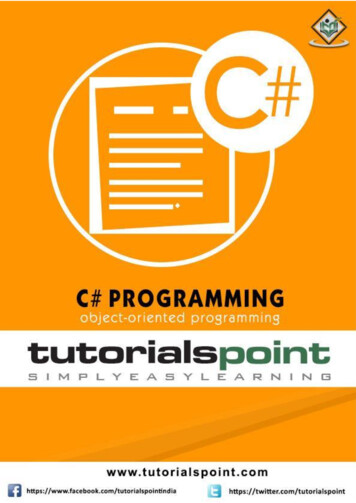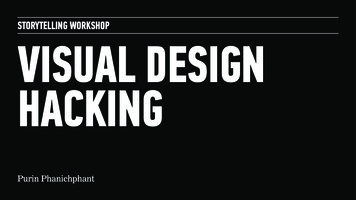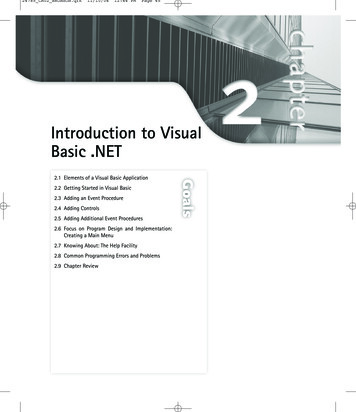
Transcription
Accommodations for AssessingStudents with Visual andAuditory Impairments withSTAAR Alternate 2Texas Association of School AdministratorsTexas Assessment ConferenceAnge Wilkins, Manager for STAAR Alternate 2February 16, 2016
Disclaimer These slides have been prepared by the StudentAssessment Division of the Texas Education Agency. If the slide is changed for local use, please removethe TEA footer at the bottom of the slide. This training in no way takes the place of reviewingrequired manuals and additional information on theTEA website.TEA Spring 2016 STAAR ALT 2 Update
AGENDA GeneralGuidelinesAccommodations & Response Modes Students with Visual Impairments Studentswith Auditory Impairments
General GuidelinesAccommodations & Response ModesSTAAR Alternate 2
When can preparations foraccommodations for students begin?Test administrators who have been trained on security andconfidentiality and have signed an oath of test security maypreview materials during the two week period prior to thetesting window.Accommodations must be prepared and completed prior tobeginning a test session. (Test Administrator Manual)
During the preview window, testadministrators should use this time to:Review the “Presentation Instructions” and “Scoring” sections ofthe Texas Administrator manual to become familiar with thepolicy for presenting and scoring questions. Practice reading the script and following the presentationinstructions for test questions while maintaining the securecontents of the assessments. Review the Scoring Instructions for test questions and planteacher assistance for specific questions. Review the student booklet to plan andprepare accommodations for any student whomay need an accommodation according to theguidelines outlined in the “Accommodations”section of the Test Administrator Manual.Critical topreview &prepare whensigning or braillingtest instructions.
Accommodation PreparationPreview WindowSTAAR Alternate 2 test materials areconsidered secure. Materials shouldremain in locked storage when not in useand should be checked in at the end of theday to the campus testing coordinator.
Who prepares the accommodations? Test administrators may include teachers (including those who hold teaching permits or probationarycertificates) Counselors Librarians paraprofessionals (certified and noncertified related service staff (currently employed by the district and routinely workwith students in the classroom) substitute teachers other professional educators (such as retired teachers) All test administrators and test administrator assistants must be trained intest security and administration procedures prior to preparingaccommodations and must have signed the test administrator oath.Refer to District Campus Coordinator Manual for more information
Who prepares the accommodations? Certified and noncertified paraprofessionals and related service staffwho are currently employed by the district and routinely work withstudents in the classroom may serve as test administrators or testadministrator assistants. The test administrator assistant can provide assistance to the testadministrator such as: preparing allowable accommodations, manipulating materials during the testing session, translating or signing information for the student, and providing behavior management.This may include therole of the intervener.The intervener is employed by the district and is equipped with specialized skillsand training to routinely provide direct support to a student with deafblindness.
Caution – A presentation should allow a studentWays to Present a Test Itemto access the test question but not provide ananswer to the question. Students mustintentionally respond to the question in order toreceive credit for a correct answer. Attach a tactilerepresentation for theimage to the studentbooklet Pair the images in thestudent booklet withobjects of the imagesOBJECTS MUST RESEMBLE THEIMAGES AS MUCH AS POSSIBLE AND REPRESENTATION MUST BEBE ORIENTED THE SAME WAY AS INPERTINENT TO THE TASK ANDANOTpiece of fur on theTHE STUDENT BOOKLETJUST SOMETHING THAT THE dog is an appropriateSTUDENT LIKESGrade 8 Science Test – STAAR Alternatetactile representationRedesignSAMPLEfor this question. Shinypink glitter would notbe appropriatebecause it could bedifficult to determinewhat the student isresponding to – the dogas required by the“find” statement orthe glitter. OriginalpresentationSeptember2014
Caution – When providing a student with a verbal description ofan image, it is important for the teacher to plan ahead. DuringWays a Test AdministratorCan Present Imagesthe preview period, the teacher should script out the languageusingImpairmentcaution not to inadvertently provide the student withto a Student with a whileVisualan answer to the “find” statement. Describe the images in thestimuli Verbaldescriptions mustbe objective and can onlyprovide information thatthe teacher sees on thepage; no additionalinformation or commentscan be provided“A girl is sitting on a big log outside. It is night time. She has made acampfire by putting rocks in a circle. Inside the circle are some sticksthat are on fire. She is rubbing her hands together.”OriginalpresentationSeptember2014
Review of Previous Training Examples Gave guidance regardingaccommodations that wereallowable such as: Putting the tactile objectin the student’s hand Guide the student’s handto specific places in thestimuli as instructions aregiven Guiding the student’s handto raised or highlightedimages Gave guidance regardingallowable response modessuch as: Pair key words in theinstructions with pictureicons or objects Use sign language tocommunicate thequestions Point to, reach for, or touch ananswerOriginalpresentationSeptember2014
Student Response Modes During STAAR Alternate 2 test administration astudent may respond using their primary mode ofcommunication or any other mode of communicationappropriate at the time of testing. student responses may be verbal, physical, or visual.The critical issue is not how the student responds but thatthe student clearly communicates the preferred answerchoice to the test administrator.
Reminder:All accommodations for STAAR Alternate 2must meet the threshold of 5 importantcriteria: Maintain the integrity of the assessment Avoid leading to or providing the student a direct answer Be used routinely in instruction, Reflect the student’s learning styles, and Allow a student to respond using a mode that isappropriate to the student.
General GuidelinesAllowable Accommodations Accommodations must be determined and prepared before the testsession begins. The test administrator must present accommodations uniformly sothat the correct answer is not emphasized over the other answerchoices. The student may need different accommodations for differentquestions within a tested subject. It IS appropriate to add language that encourages the student to stayon task. It is NOT appropriate to add language about the content ofthe question.
General GuidelinesAllowable Accommodations Routinely used accommodations for positioning and behavioralsupports can be provided for any student to ensure that the studentcan physically access the stimuli provided and maintain focusthroughout the testing session. Test administrators may use, but are not limited to: Picture communication symbols Studycarrels Tokenboards Sensoryitems Adaptivefurniture
General GuidelinesAllowable AccommodationsRoutinely used accommodations for positioning and behavioral supports can beprovided for any student to ensure that the student can physically access the stimuliprovided and maintain focus throughout the testing session. Test administrators may enhance the visual efficiency of thetesting environment and reduce visual anxiety including, but nolimited to: using task lighting, spotlights or dimmers; positioning the student so that light (natural or artificial) comesfrom behind the student to reduce glare; presenting test items within the student’s visual range and fieldlosses; presenting test items on a tactile bulletin board, easel, slantboard or stand; and limiting excess noise and proprioceptive distractions
Students with Visual ImpairmentsSTAAR Alternate 2
Color or highlight images or textTest administrators ORstudents may draw attentionto images or text by: outliningorhighlighting images; coloring images(partially orcompletely); highlighting,underlining andcircling text.
Place color overlays on images or textTest administrators may createvisual contrast in images or textby―Providing transparent,tinted overlays;Test Item―Using high-contract orcolored backgrounds topresent text and images.*Test may not be scannedAccommodations
Place color overlays on images or textTest ItemTest administratorsmay create visualcontrast in images ortext by applyingnegative text effectsto backgrounds,images and fonts.*Test may not be scannedAccommodation
Pair images or text with photographs, picturerepresentations, or real objects of the same content Test administrators may use anycombination of actual pictures, picturesymbols or real objects (partial orcomplete) to support images or text. Take time for tactile modelingbefore and during each cluster andtest item; Give the student opportunities forindividual tactile exploration andmutual tactile exploration with thetest administrator before the“find” statement has been given,and during the item presentation;
Pair images or text with photographs, picturerepresentations, or real objects of the same contentTest administrators may use any combination of actual pictures, picturesymbols or real objects (partial or complete) to support images or text.
Pair images or text with photographs, picturerepresentations, or real objects of the same contentTest administrators may use a combination of actual pictures, picture symbols orreal objects (partial or complete) to support images or text.Test ItemAccommodations
Attach textured materials to images or textTest administrators may include various sensory objects withimages or text.Test Items— Texture— SmellAccommodations
Demonstrate concepts or relationshipsin images or textTest administrators or students may perform or exemplifyconcepts or relationships presented in images.An example is to allow students to actively participate in thepresentation for example: Tactile modeling – The test administrator models anaction or activity while the student is following theaction through touch.
Raise or darken the outline in imagesor textTest administrators may incorporatetactile graphics in images or text by Increasingthe weight of lines inimages or text; or Applyingtexture enhancers such aspuff paint, fabric, yarn, etc.
Raise or darken the outlinein images or text Test administrators may incorporate tactilegraphics in images or text, including but notlimited to: Collage Tooling Sculpture Embossed braille images
Enlarge image or text Test administrators may enlarge images ortext by allowing the student to use highand low tech vision devices, including butnot limited to:Electronic projection or magnificationdevices on a screen or computer monitorPage magnifiersTracking magnifiersBinoculars, monocular, loupes
Enlarge images or textTest administrators may enlarge images or text byTest Item photocopying images or text(copier’s memory must beerased); or eliminating unnecessaryelements of the image. Accommodation may NOT leadstudent to the correct answer.Accommodation
Add braille labels to images or providetext in braille May include brief labels of student booklet stimulus. Test administrators should use vocabulary appropriatefor student’s cognitive level and grade level, Test administrators should give strong considerationto the student’s braille reading ability. This shouldguide the depth and breadth of braille support.Braille labels and text should be returned to district testing coordinator withphotocopies and other secure materials when returning non-scorable materials.
Describe images forstudents with visualimpairmentsDescriptions of images can onlyinclude details of what can beseen in the images withoutcomments about the overallimpression of the image.ObjectsAre therepeople,trees, cars?ColorsWhat arethe colors inthe image?Are thepeoplemale,female?OriginWhere arethey from?SeasonDuring whatseason wasthe imagetaken?ActionsWhat arethey doing?MessageWhat is thepurpose ofthe image?NumbersHow manyare there?EmotionAre theyhappy, sad,etc?LocationWhere wasthe imagetaken?
Describe images for students with visualimpairmentsSpecial considerations should be made for the cognitive level of thestudent and their ability to understand language.Adhere to the five criteria for ALL STAAR Alternate 2 accommodations: Maintain the integrity of the assessment Avoid leading to or providing the student a direct answer Be used routinely in instruction, Reflect the student’s learning styles, and Allow a student to respond using a mode that is appropriate to thestudent.
Describe images for students withvisual impairmentTest item stimuliExample of image description“On this page there is a drawingof a park with 4 tall tress. There isa woman standing close to onebig tree. She is a tall thin woman.She is holding a big sign over herhead that says in big letters,“Save the Trees.” She is notsmiling. She looks upset. There isa man driving a big bulldozer. Heis pushing over one of the treeswith the bulldozer.”
Provide images or text on separate paperpresented one at a timeImages must be presented in the same order or configuration asthey appear in the test booklet. Photocopiedpages containing sentences/phrases canbe cut into strips to increase spacing betweensentences and/or paragraphs. Sectionscan be pointed to or highlighted as they arementioned in the instructions Partsof the stimulus can be covered up until explainedin the instructions.
Cover or Isolate images or text until addressed Some examples of this might consist of: Provide a word of sentence window Use a line guide while the student follows along Allow the student to use a slider card
Use calculator to arrive at responsesTest administrator may allow students to use calculationdevices and/or math calculation materials, such as:Large button calculatorsText-to-speech (talking) calculatorsAbacusHundreds chart, number line, place value chart
Students with Auditory ImpairmentsSTAAR Alternate 2
General GuidelinesSigning Test Instructions Sign language used for STAAR Alternate 2 should beconsistent with the sign language used during classroominstruction. When providing a signed administration of STAAR Alternate2 to a student who is deaf or hard of hearing, the studentshould receive the same level of access to test items as astudent who receives an oral administration.
General GuidelinesSigning Test Instructions Student should be positioned so that test items are madeaccessible both in sign and print. Adjust the sign placement and style to best fit the testitem. Specific test item directions may be further clarified orinterpreted as long as the substance of the directions isnot changed. The student may be alerted through sign as to where tolook or focus during the “Direct” portion of testinstructions.
Signing Test ContentIf a sign for a word or phrase exists, the testadministrator should use the sign when the word orphrase occurs in print on the test.Signs that are commonly used in sign language are allowablein the signed administration of state assessments. For example, if an item asks the student to identify a triangle, acommonly used sign is a pantomimed drawing of a triangle. Thismay be a commonly accepted sign used in conversation andinstruction and therefore could be the sign that is used when theEnglish word “triangle” appears in the test.
Signing Test ContentIf a word or phrase has been locally developed androutinely used in instruction, the test administrator mayuse the sign when the word or phrase occurs in print onthe test.For much of the vocabulary used in instruction, there are notcommonly used signs. In many cases, teachers or sign languageinterpreters will develop signs for frequently used vocabulary, withthe understanding that these are locally developed signs for aparticular instructional setting. These locally developed signs may beused in a signed administration if they are regularly used duringinstruction.
Signing Test ContentIf there is no commonly accepted sign for a word orphrase and a local sign has not been developed, thetest administrator must determine if the word orphrase IS or IS NOT the concept being assessed. .Fingerspelling is the least preferred alternative here as itmay increase the difficulty beyond what a hearing studentwould be required to do.Visual symbols may be a preferred alternativeaccommodation when sign is not the preferred mode for thestudent taking the STAAR Alternate 2 assessment.
Demonstrate concepts or relationshipsin images or text Test administrators or studentsmay demonstrate or exemplifyconcepts or relationshipspresented in images or text. Critical aspects of reading tohearing students are style ofspeech, tone, intensity, voiceinflection, intonation andvolume to give life to conceptspresented Critical aspects of reading todeaf students are: signing styleand sign placement, physicallydemonstrating concepts, usingreal objects connected to text,exaggerating facial expressionsand involve the student to givelife to the concepts presentedin the story.
Provide structured remindersTest Administrators may provide cues and gestures either forreceptive communication or to refocus a student’s attentionsuch as: Touch cues – a touch immediately preceding an action oractivity Object cues – an object presented to convey a messageabout a specific activity Auditory cues – taps on a surface to orient the student to theanswer choices or to make the student aware of objectlocation
Structured RemindersCommonly used structured remindersinclude but are not limited to:personal timers,token systems,color-coded reminders,handwritten reminders,visual schedules.
ResourcesEducator Guide State of Texas Assessment of AcademicReadiness Alternate 2 (STAAR Alternate 2)—RevisedSeptember 20152016 District and Campus Coordinator ManualTest Administrator Manual 2016 STAAR Alternate 2(Non-Secure Front Matter)Assessments for Students with Disabilities 2015 Fall Update TETN(PPT posted 09/17/15)UPDATED STAAR Alternate 2 Test Administration TETN(PPT)TEA Spring 2016 STAAR ALT 2 Update
Unique Requests and Questions and SupportTEA defines accommodations as changes to materials or proceduresthat enable students with disabilities to participate meaningfully inlearning and testing.When student needs fall outside of the posted allowableaccommodations, please contact TEA for specific guidance.For any other questions or support, please contact TEA for guidance:Texas Education Agency (TEA)Phone: (512) 463-9536Email: staaralt@tea.state.tx.us
Texas Association of School Administrators Texas Assessment Conference. Ange Wilkins, Manager for STAAR Alternate 2. February 16, 2016. Disclaimer .










